The dance, in addition to its artistic expressiveness, has played a significant role as a form of therapy over the years.
This article deeply explores the benefits of dance for mental and physical health, highlighting how this practice transcends mere physical activity, becoming an effective tool to promote integral well-being.
Table of Contents
- I. Introduction
- II. Body Expression as Emotional Language
- III. Physical Benefits: Fortification, Flexibility and Coordination
- IV. Dance as a Recovery Tool: Case studies
- V. Therapeutic Approaches: Movement Dance and Belly Dance as Examples
- VI. Dance in Mental Health: Reducing Anxiety and Depression
- VII. Inclusion and Community: Dance as a Socializing Agent
- VIII. Challenges and Ethical Considerations in Therapeutic Dance
- IX. The Future of Dance Therapy: Innovations and Research in Progress
- Conclusion: Dance as Holistic Healing
I. Introduction
The connection between the dance and therapy dates back to ancient civilizations, where dances were performed as healing rituals. Today, therapeutic dance is recognized as a holistic approach to health, benefiting both body and mind.
II. Body Expression as Emotional Language
Dance provides a unique form of emotional expression. Through body movements, individuals can release repressed emotions, promoting catharsis and relieving emotional stress. We will explore how dance serves as a non-verbal language, allowing people to express feelings that may be difficult to articulate in other ways.
III. Physical Benefits: Fortification, Flexibility and Coordination
In addition to the emotional benefits, dancing is a complete physical activity. We will cover how different dance styles promote muscle strengthening, improving flexibility and developing motor coordination, providing not only therapeutic benefits, but also contributing to general physical health.
IV. Dance as a Recovery Tool: Case studies
We will examine case studies that illustrate how dance has been used as an effective recovery tool in mental health settings. From contemporary dance used in rehabilitation programs to social dance as a means of integration into communities, These cases highlight the versatility of dance as therapy.
V. Therapeutic Approaches: Movement Dance and Belly Dance as Examples
We will discuss specific therapeutic approaches, like the busy dance (dance movement therapy) and belly dancing, exploring how these practices are structured to meet participants' specific needs and promote healing through movement.
VI. Dance in Mental Health: Reducing Anxiety and Depression
We will investigate how dance is effective in reducing anxiety and depression. We will address the neuroscientific bases of these effects, highlighting how dancing releases endorphins, neurotransmitters associated with emotional well-being, and promotes positive changes in the brain.
Sign up to receive Event News
and the Universe of Arts first!
VII. Inclusion and Community: Dance as a Socializing Agent
Therapeutic dance often happens in a group setting, providing an opportunity for community building and social inclusion. We'll explore how dance can be a powerful tool for creating social bonds and combating isolation.
VIII. Challenges and Ethical Considerations in Therapeutic Dance
We will analyze the ethical challenges associated with the practice of therapeutic dance, addressing issues such as consent, cultural sensitivity and the importance of qualified healthcare professionals in facilitating these activities.
IX. The Future of Dance Therapy: Innovations and Research in Progress
We will conclude the article by examining emerging innovations in the area of therapeutic dance and ongoing research. How science and practice continue to come together, We anticipate a future where therapeutic dance will play an even more prominent role in promoting mental and physical health.
Conclusion: Dance as Holistic Healing
In a world increasingly focused on holistic approaches to health, dance stands out as a powerful healing tool.
By recognizing and embracing the mental and physical health benefits of dance, we can not only appreciate its aesthetic beauty, but also value its unique ability to promote integral well-being.

